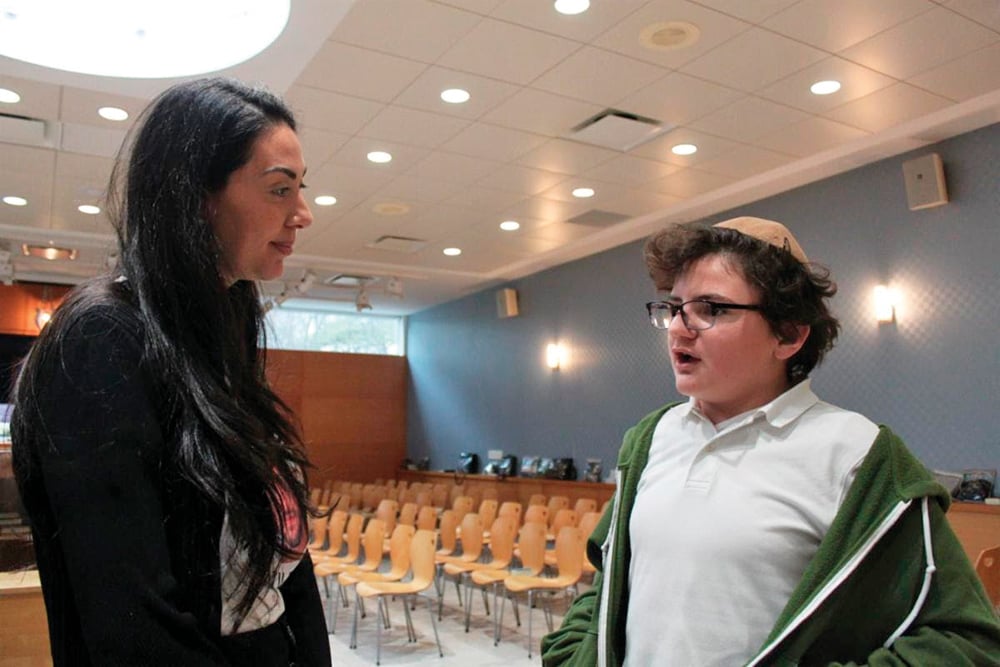The Real Housewives franchise may celebrate affluent women in various regions throughout the United States, but it’s a safe bet none of them ever led a fight for fair working conditions on the Lower East Side, including protesting soaring prices of food or unfair rents. For that, it took Jewish women, most of them housewives and mothers, who organized themselves into a fighting force that today would be almost unimaginable.
Their story was told recently by Jennifer Young, a historian, writer and former director of education at the YIVO Institute, who was asked by the Lower East Side Jewish Conservancy to speak on “Radical Housewives: Jewish Women’s Activism on the Lower East Side and Beyond.”
“I just fell in love with these women,” said Young. “A group of Jews who believed strongly in activism and Yiddish as part of their identity, and were never sucked into other issues, such as suburbanization or big synagogue denominations or even leaving their immigrant past behind. To their last days, they thought about injustices, especially surrounding issues of food. Because they knew what it meant to be immigrants themselves, they understood what exploitative jobs could do to someone, and they tried to reach out to new immigrant groups.”
Radicalized by Books
The heroine of the evening was the legendary Clara Lemlich, a leader of the 1909 Shirtwaist Garment Strike, which became known as the “Uprising of the 20,000,” as well as a series of riots promoting consumer activism through food and rent strikes and boycotts.
Born in 1886 in Russia, where her mother ran a grocery and her father studied in a beit midrash, Lemlich radicalized herself by hiding in the attic on Shabbat and reading Russian novels. In 1903, in the wake of the bloody Kishinev pogrom, the family emigrated to the Lower East Side of Manhattan. In 1906, she organized her first strike, which failed, but it netted Lemlich valuable experience as a labor organizer, a background that would serve her well in what became her life’s work.
Kosher Meat Riot
At the turn of the 20th century, many immigrant families on the Lower East Side lived in dark, crowded, unsanitary tenements for which they paid the rent by working long hours in factories and sweatshops. The average salary at the time was $40 per month, of which $15 went for rent and $22 was allotted for food based on 76 cents per meal. When the prices of food began skyrocketing, housewives, many of them immigrant Jews, took matters into their own hands.
In May of 1902, when almost overnight kosher meat prices rose from 12 to 18 cents per pound, Jewish women instigated an action that became known as the Kosher Meat Riot of 1902. The women’s protests included a march down East Broadway to City Hall with signs reading “We want food,” and boycotts that left meat rotting on store shelves.
As a result, some 400 kosher butchers, who blamed the wholesalers, shut down. But the wholesalers, run by meat trusts, proved too powerful, forcing the butchers to reopen.
At that point, 20,000 women took to the streets, smashing kosher butcher shop windows, pouring gasoline on the meat, lighting the fires and throwing pieces of meat at the police officers who were trying to keep order. At the end of the first day, some 85 people had been arrested, 64 of them women, many treated brutally by the police.
The struggle expanded to local synagogues, where women convinced men praying during the Sabbath to ask their wives to join the protest, and anyone caught buying kosher meat was ridiculed as a “scab.” As a result, virtually all purchases of kosher meat stopped, and the kosher butchers shut down again in solidarity with their customers. In addition, kosher restaurants throughout New York City removed meat items from their menus. With the support even from Orthodox religious leaders, the boycott was successful, forcing the price of meat to drop to 14 cents per pound.
The tactic was repeated time and again during the early decades of the 20th century as housewives in other Jewish communities in Harlem, Brooklyn, Newark, Boston and Philadelphia followed the lead of their counterparts on the Lower East Side.
1917 Boycott
In February of 1917, Lemlich, who had made her name by convincing 20,000 of the 32,000 workers in the shirtwaist trade to walk out on strike, forcing almost every sweatshop in Manhattan to agree to union contracts, turned her attention to food prices.
Like in 1902, the rise in food prices came as a surprise. Families were forced to sell furniture just to put food on the table. Children were taken out of school to work.
“When mothers were forced to work outside the home, their older daughters had to stay with the younger ones instead of going to school,” said Young. “These were the daughters of the 1902 protesters, and they had more tactics at their disposal than their mothers had had.”
This time, the Jewish housewives organizing the boycotts of onions, potatoes and chicken were not only from the Lower East Side, but also Brooklyn and the Bronx. The organizers, including Lemlich, told them to buy only bread, butter and milk and to avoid meats and vegetables. Five thousand women, many of them carrying babies, gathered at protest meetings in a hall built to hold only 1,000 and carried signs in English and Yiddish: “Down With Capitalism” and “In the Richest Country in the World, Why Do We Have So Little to Eat?”
“As a result, no Jewish peddlers or store owners could sell chicken, fish or vegetables, and as the stock began to spoil, prices fell, but still no one would buy. Mountains of onions began to rot on wholesalers’ shelves,” said Young.
The boycott was a success, and in just a few weeks, wholesalers were forced to lower their prices.
Rent Strikes
A year later, Lemlich, who had married Joe Shavelson, a printer, and moved to the Brownsville section of Brooklyn, began organizing tenant advocacy groups and launched a militant rent strike.
“She forced a rollback of rents in her buildings,” said Young.
To further organize women for the causes she felt were important, she created the United Council of Working-Class Housewives, a group that went door to door in buildings, mobilizing women to become members and elect delegates to take on issues such as school overcrowding, tenement safety conditions and rent prices.
“She held baby carriage parades and had no patience when women told her they would have to ask their husbands before they could commit. She wrote articles, telling men that if they were progressive themselves, they would have to babysit so their wives could go to political meetings,” said Young.
These housewives with a mission focused their activities on supporting Jewish and Black women, creating kitchens to feed and playgroups to care for the children of strikers.
Communist Party
By 1924, Lemlich had given birth to her third child and the family relocated to Brighton Beach.
“This was where people voted for the Communist Party and sang revolutionary songs in Yiddish and Russian on the boardwalk,” said Young
Finally, in 1926, at the age of 40, Lemlich joined the Communist Party, and, by the time the Depression came, she was ready for it. In 1930 and 1932, she and the United Council of Working-Class Housewives led hunger marches in Washington and fought for home relief and unemployment insurance.
Free Milk
In 1933-1934, when milk prices rose by 28%, they campaigned for free milk and lower prices, and, in 1935, they led a national boycott on the price of meat because they felt that, once again, the wholesalers were driving up the prices. This time, most of the kosher butchers shut their stores in sympathy with the boycotters, and those that didn’t were targeted by the women who forced them to lock their doors and close their windows. In the first week, 3,000 of New York’s 4,500 kosher butcher shops were closed.
“The boycott extended to non-kosher butchers as well, Wholesalers were stuck with hundreds of pounds of meat, and the losses were staggering throughout Jewish and African-American neighborhoods,” said Young.
“One commissioner told the women to eat more fish because it was cheaper than meat, but the women’s strike resulted in a tremendous growth of vegetarianism,” said Young.
Fighting With Hatpins
When harassed by police, these women gave back as hard they took. Lemlich and her supporters were not above stabbing police horses with their hatpins, causing the animals to jump and throw their riders.
“These women thought that was fair play. They were getting beaten up and kicked down flights of stairs, and when they fought back, they smashed department store windows and disrupted the mayor’s meetings in city hall,” said Young.
After a few weeks, although prices were going down, the boycott simply became too dangerous to continue.
“The meat packers were closely connected to the mafia, and the police were protecting them. So the women did the best they could. They declared victory and called off the strike,” said Young.
The Emmas
In 1931, Lemlich had created the Emma Lazarus Tenants Council in Brighton Beach to lead rent strikes throughout Brooklyn. “When landlords put evicted families’ furniture out on the street, the Emmas, as they began to be called, would bring the furniture right back in again,” said Young.
The name remained important when the United Council of Working-Class Housewives became the Progressive Women’s Council, and eventually part of the International Workers Order (IWO), a Communist Party affiliate. The IWO hired Lemlich as an organizer in its women’s section, which had councils divided according to ethnicity.
Tens of Thousands of Members
From 1950 until the group’s demise in 1990, it became known as the Emma Lazarus Federation of Jewish Clubs and, at its height, boasted tens of thousands of members in chapters across the country.
“The name sounded benign, but it was still a communist group mixing women’s political activism with Jewish culture and identity. The Emmas represented a new kind of progressive Jewish politics and a new kind of Jewish women’s activism,” said Young.
The group flourished at a time when Yiddish was no longer the language of the Jewish people and, for many, it was an embarrassment, but not to the Emmas. Most of its members still spoke Yiddish, and when they deigned to speak English it was with heavy Yiddish accents. Officially, it was a bilingual organization.
“They believed in strong, secular-Jewish identity, and Yiddish culture, language and literature was how they spoke to their children,” said Young.
To that end, they raised money to support Jewish afternoon schools to teach Yiddish and Jewish culture across the country. As with all their fundraising, it was mostly in small amounts, raised mostly from women with whom members made contact, often in playgrounds or parks.
No Melting Pot, No Assimilation
In 1947, at the first national convention of the Emmas, they railed against the theory of the American melting pot, which they discounted as a hoax, similar to what they saw as the false idea of assimilation as the key to success or the concept that a woman’s place was in the home.
“For the Emmas, a woman’s place was anywhere she wanted to be, especially on the picket line,” said Young.
They opposed assimilation, which they saw as a tool of the ruling class to turn Jews against each other because they would no longer have a sense of who they were. Despite their devotion to communism, the Emmas considered themselves Zionists who built and maintained a child-care center in Tel Aviv for working-class women—Jews and Arabs. They also advocated for admitting Jews into the United States after World War I.
Fighting Racism
Above all, they were dedicated to the fight against racism, which included fostering understanding between Jews and non-Jews and white and Black Americans.
“For them, racism was as serious as anti-Semitism,” said Young, explaining that they worked to partner with African-American women’s organizations.
The Emmas made a name for themselves when they fought for equal insurance rates for whites and Blacks, an unheard-of cause when they took it up. That issue in addition to workers’ rights, including Caesar Chavez’s migrant workers, soon brought these aging Yiddish-speaking women, most of them, like Lemlich, widows in their 70s and 80s, to the attention of the FBI.
Infiltrated With Informers
According to Young, during the Cold War, the FBI knew the names of every officer in every Emmas chapter in the country.
“They knew how much money each chapter had in its bank account, who donated the flowers to the monthly luncheons and whether the main dish at the luncheon was hot or cold,” she said.
Aware of their surveillance by the FBI, the Emmas chapters did not have listed phone numbers and never maintained master lists of their members, fearing it would fall into the wrong hands. They assumed all their mail was opened before it was delivered and that all meetings were infiltrated by informers.
“In fact, they were routinely informed on to the FBI by other Jewish women,” said Young.
Shunned by Communists and Jews
The FBI might have thought these women were a window into the workings of the American Communist Party, but, in fact, the party cared little about the Emmas, seeing them as pretty much just what they were: a group of older Jewish women activists whose activities and interests were their own and had nothing to do with the party.
“In the ’50s and ’60s, the Emmas were actively involved in the civil rights movement, and they invited the women of Hadassah, many of whom shared their ideals, to join them, but officially the Emmas were frozen out,” said Young.
Communists to the End
By the 1970s, many of the Emmas had left the Northeast to live in California, but even there, they were more identified with the cities than suburban life.
“They were mostly elderly, widowed women who didn’t drive and would have been isolated in the suburbs. They retired to Los Angeles, especially to the neighborhood of Venice Beach, where the temperature was warm, they could walk where they wanted to go or take a bus, and it was comparatively cheap,” said Young.
To the end, these first-generation Jewish immigrant women remained true to their political beliefs. “There’s no question they saw communism through rose-colored glasses,” said Young.
Two Sues on the Aisle bases its ratings on how many challahs it pays to buy (rather than make) in order to see the program being reviewed. “Radical Housewives: Jewish Women’s Activism on the Lower East Side and Beyond” received four challahs.
By Sue Weston and Susie Rosenbluth,
Two Sues on the Aisle/TheJewishVoiceAndOpinion.com













